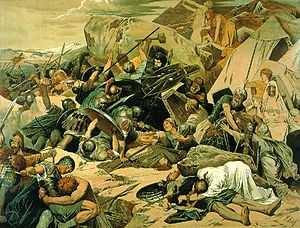553
| Millennium: | 1st millennium |
|---|---|
| Centuries: | 5th century – 6th century – 7th century |
| Decades: | 520s 530s 540s – 550s – 560s 570s 580s |
| Years: | 550 551 552 – 553 – 554 555 556 |
| 553 by topic | |
| Politics | |
| State leaders – Sovereign states | |
| Birth and death categories | |
| Births – Deaths | |
| Establishment and disestablishment categories | |
| Establishments – Disestablishments | |
| Gregorian calendar | 553 DLIII |
| Ab urbe condita | 1306 |
| Armenian calendar | 2 ԹՎ Բ |
| Assyrian calendar | 5303 |
| Bengali calendar | −40 |
| Berber calendar | 1503 |
| Buddhist calendar | 1097 |
| Burmese calendar | −85 |
| Byzantine calendar | 6061–6062 |
| Chinese calendar | 壬申年 (Water Monkey) 3249 or 3189 — to — 癸酉年 (Water Rooster) 3250 or 3190 |
| Coptic calendar | 269–270 |
| Discordian calendar | 1719 |
| Ethiopian calendar | 545–546 |
| Hebrew calendar | 4313–4314 |
| Hindu calendars | |
| - Vikram Samvat | 609–610 |
| - Shaka Samvat | 475–476 |
| - Kali Yuga | 3654–3655 |
| Holocene calendar | 10553 |
| Iranian calendar | 69 BP – 68 BP |
| Islamic calendar | 71 BH – 70 BH |
| Julian calendar | 553 DLIII |
| Korean calendar | 2886 |
| Minguo calendar | 1359 before ROC 民前1359年 |
| Seleucid era | 864/865 AG |
| Thai solar calendar | 1095–1096 |
| Wikimedia Commons has media related to 553. |

The Battle of Mons Lactarius (553)
Year 553 (DLIII) was a common year starting on Wednesday (link will display the full calendar) of the Julian calendar. The denomination 553 for this year has been used since the early medieval period, when the Anno Domini calendar era became the prevalent method in Europe for naming years.
Events
By place
Byzantine Empire
- Battle of Mons Lactarius: In a secret, well conducted march, king Teia joints forces with his brother Aligern in Campania. They march to relieve the siege of Cumae. Meanwhile at Mons Lactarius (modern Monti Lattari) Narses lays an ambush. The combined Gothic force is crushed in a hopeless last stand for two days (south of Naples) and Teia is killed in the fightings. Aligern escapes, but surrenders a few months later.
- The end of the Ostrogothic Kingdom after 60 years of rule in Italy. The Goths are allowed to return to their homes in peace and (re)settle in modern-day Austria. Some 7,000 people retreat to Campsas (Southern Gaul) and resist with minimal help from the Franks against the Byzantines until 554.
Europe
- Gothic War: Frankish invasion — Two Frankish-Alemanni dukes; the brothers Lothair and Buccelin, cross the Alps from Germany with a force of 75,000 men, mostly Frankish infantry. In the Po Valley, they win an easy victory over a much smaller Byzantine force at Parma, and are joined by remnants of the Gothic armies, bringing the total strength of the invaders to about 90,000 men. Narses, gathering his forces as quickly as possible, marched north to harass the Franks, but is not strong enough to engage them in battle. In Samnium (Southern Italy) the brothers divide their forces; Lothaire goes down the east coast, then returns to the north, to winter in the Po Valley. Buccelin follows the west coast to the very toe of the boot into Calabria, where he spent the winter — his army being seriously wasted by attrition and disease.
Asia
- King Seong of Baekje attacks the kingdoms of Goguryeo and Silla. However, under a secret agreement, Silla troops, attack the exhausted Baekje army and take possession of the entire Han River valley.
- In the Turkic Khaganate Istemi is appointed governor (yabgu) in the west of the empire (modern Turkestan) and Muqan Qaghan succeeds his brother Issik Qaghan as emperor (khagan) of the Göktürks.
By topic
Religion
- May 5 – The Fifth Ecumenical Council is held in Constantinople. Emperor Justinian I condemns in an edict the Three Chapters, causing further schisms and heresies of monoenergism and monothelitism.
Births
Deaths
- Gelimer, king of the Vandals and Alans (b. 480)
- Issik Qaghan, ruler of the Turkic Khaganate
- Teia, king of the Ostrogoths
- Xiao Ji, prince of the Liang Dynasty (b. 508)